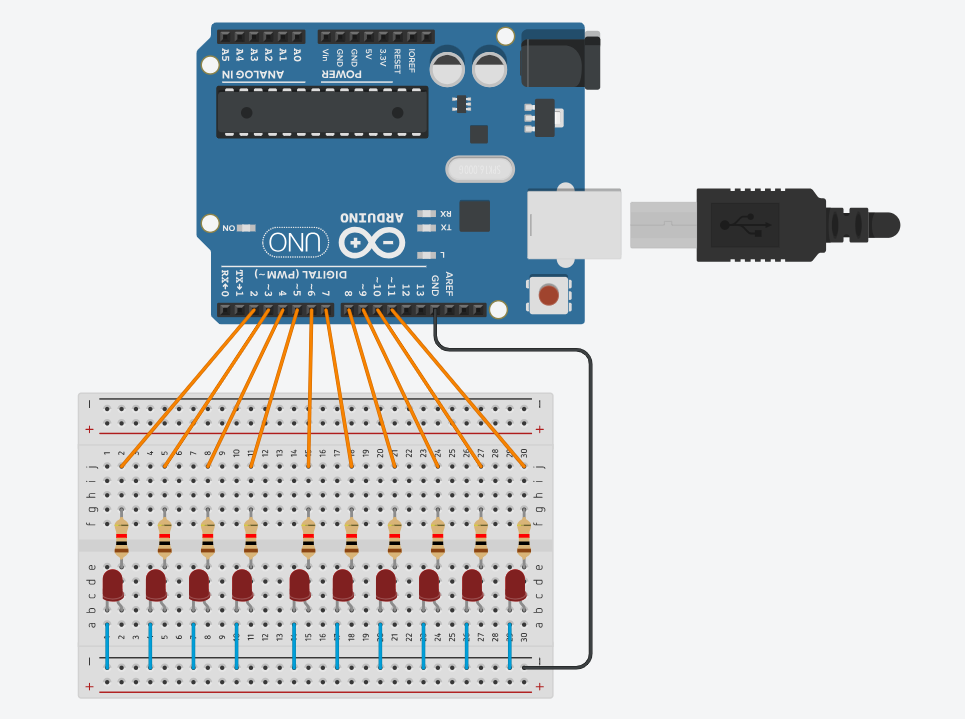Arduino(に似たやつ)を使って2進数時計を作りました。
Arduino、回路ともに初心者なので温かい目で見ていただけると嬉しいです。
目次
・材料
・配線
・プログラム
・注意点
・まとめ
材料
・ELEGOO Arduino用UNO R3
・LED 赤 ×10
・抵抗器 1kΩ ×10
・ジャンパー線 ×21
配線
配線は以下の通りです。
プログラム
Python側のプログラムは、現在時刻の時刻データを1秒ごとに送信するプログラムで、Arduino側のプログラムは、Pythonから送信された時刻データを2進数に変換しLEDに表示するプログラムです。
Arduino
String inputTime = "";
int hours = 0;
int minutes = 0;
int seconds = 0;
unsigned long previousMillis = 0;
const long interval = 1000; // 1秒ごとの更新間隔
int hourPins[] = {2, 3, 4, 5}; // 時を表示するピン
int minutePins[] = {6, 7, 8, 9, 10, 11}; // 分を表示するピン
void setup() {
Serial.begin(9600);
// ピンモードを出力に設定
for (int i = 0; i < 4; i++) {
pinMode(hourPins[i], OUTPUT);
}
for (int i = 0; i < 6; i++) { // 分を表示するためのピンを6つに設定
pinMode(minutePins[i], OUTPUT);
}
}
void loop() {
// シリアル入力がある場合、時刻データを読み取る
if (Serial.available() > 0) {
inputTime = Serial.readStringUntil('\n');
if (parseTime(inputTime)) {
// 時刻が正しく解析された場合、LEDに表示
int displayHour = convertTo12HourFormat(hours); // 12時間制に変換
displayBinary(displayHour, hourPins, 4); // 12時間制で表示
displayBinary(minutes, minutePins, 6); // 分を表示
}
}
// 1秒ごとの更新処理
unsigned long currentMillis = millis();
if (currentMillis - previousMillis >= interval) {
previousMillis = currentMillis;
seconds++;
if (seconds >= 60) {
seconds = 0;
minutes++;
}
if (minutes >= 60) {
minutes = 0;
hours++;
}
if (hours >= 24) {
hours = 0; // 24時間制としてリセット
}
}
}
// 入力された時刻を解析して設定する関数
bool parseTime(String timeString) {
timeString.trim(); // 不要な空白を削除
int firstSpace = timeString.indexOf(' ');
int secondSpace = timeString.indexOf(' ', firstSpace + 1);
if (firstSpace == -1 || secondSpace == -1) {
return false; // フォーマットが正しくない場合
}
String hourString = timeString.substring(0, firstSpace);
String minuteString = timeString.substring(firstSpace + 1, secondSpace);
String secondString = timeString.substring(secondSpace + 1);
hours = hourString.toInt();
minutes = minuteString.toInt();
seconds = secondString.toInt();
// 時間、分、秒の範囲をチェック(24時間制で入力)
return (hours >= 0 && hours < 24 && minutes >= 0 && minutes < 60 && seconds >= 0 && seconds < 60);
}
// 24時間制を12時間制に変換する関数
int convertTo12HourFormat(int hour24) {
if (hour24 == 0) {
return 12; // 0時は12時として表示
} else if (hour24 > 12) {
return hour24 - 12; // 13時以上は12を引いて12時間制にする
} else {
return hour24; // 1~12時はそのまま表示
}
}
// 2進数をLEDに表示する関数
void displayBinary(int value, int pins[], int length) {
for (int i = 0; i < length; i++) {
int bit = (value >> i) & 0x01;
digitalWrite(pins[i], bit); // ピンに反映
}
}
Python
import serial
import time
from datetime import datetime
# Arduinoとのシリアル通信を初期化
arduino = serial.Serial('COM12', 9600)
time.sleep(2) # Arduinoが起動するまで待機
while True:
# 現在の時刻を取得
now = datetime.now()
current_time = now.strftime("%H %M %S") # HH MM SSフォーマットに変換
# 現在の時刻をArduinoに送信
arduino.write(current_time.encode('utf-8') + b'\n')
print(f"Sent Time: {current_time}") # 送信した時刻を表示
time.sleep(1) # 1秒ごとに送信
githubにもプログラムを公開しています。
https://github.com/KabutoEbi/BinaryClock
注意点
・Pythonでシリアルポートを使用するため、ArduinoIDEでシリアルモニターを開いていると動作しません。ArduinoIDEのシリアルモニターは閉じるようにしましょう。
・現在時刻を表示し続けるためには、常にPythonのプログラムを動かし続ける必要があります。
まとめ
今回は現在時刻を2進数で表示する2進数時計を作りました。RTCモジュールを使用すればもっとコンパクトな回路になるのですが、少ない材料で作成できるようRTCモジュールは使用しませんでした。
